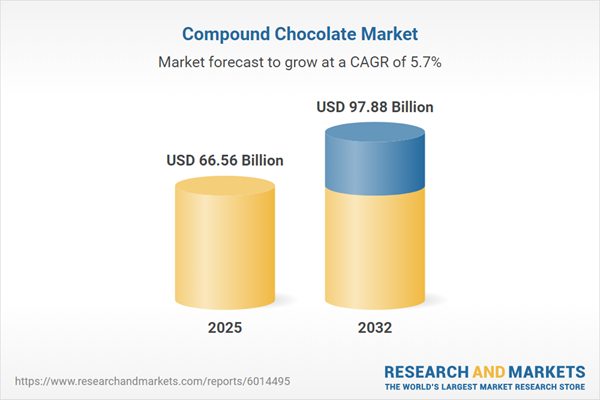Speak directly to the analyst to clarify any post sales queries you may have.
Compound chocolate is becoming a central ingredient for manufacturers adapting to global shifts in supply chains, consumer expectations, and operational risk. Senior executives recognize its broad potential for supporting production flexibility, cost management, and strategic growth across diverse product lines.
Market Snapshot: Compound Chocolate Market Size and Growth Overview
The compound chocolate market is experiencing steady growth, moving from USD 63.02 billion in 2024 to USD 66.56 billion in 2025 and forecasted to reach USD 97.88 billion by 2032. This 5.65% CAGR demonstrates robust expansion. Growth is driven by the increasing shift toward cost-efficient chocolate alternatives that appeal to established industry leaders and emerging players alike. Broader use in confectionery, bakery, and beverage sectors highlights ongoing diversification of applications. Evolving regional consumption, regulatory trends, and adaptive product development continue to open new pathways for leadership and targeted strategic expansion.
Scope & Segmentation of the Compound Chocolate Market
This report provides comprehensive, actionable segmentation to support senior decision-makers in navigating the compound chocolate market and informing strategy amid changing market dynamics.
- Types: Dark, milk, and white compound chocolates enable tailored product innovation for diverse consumer tastes, ideal for snacks, desserts, and specialized offerings.
- Applications: Widely adopted across bakery goods, desserts, beverages, confectionery, dairy, and smoothies, delivering value to major industry players and specialized niche producers aiming to capture evolving consumption patterns.
- Distribution Channels: Includes convenience stores, supermarkets, hypermarkets, and digital e-commerce channels, supporting accessibility for B2B clients and retail partners in various market environments.
- Forms: Blocks, chips, chunks, and slabs increase production flexibility, enabling efficient manufacturing for both volume-driven and specialty segments.
- Geographic Regions: Strategies designed with a focus on the Americas, Europe, Middle East & Africa, and Asia-Pacific allow response to regional consumption preferences and regulatory demands, emphasizing the importance of local compliance and market adaptation.
- Technologies and Trends: Advances include sustainable sourcing, supply chain digitalization, development of plant-based emulsifiers, and improved fat traceability, ensuring operational resilience and stronger competitive positioning.
- Leading Companies: Market direction is shaped by Barry Callebaut AG, Cargill, Incorporated, Puratos NV, Fuji Oil Holdings, Blommer Chocolate Company, Archer-Daniels-Midland Company, Olam International Limited, The Hershey Company, Mars, Incorporated, and Mondelēz International.
Key Takeaways for Senior Decision-Makers
- Product advancements and modernized manufacturing processes empower companies to respond quickly to evolving market demands and open new channels for innovation.
- Strengthening ethical sourcing and adherence to clean label standards helps differentiate brands while deepening trust with B2B buyers and end customers.
- Agile supply chain strategies, emphasizing transparency and adaptability, support business continuity in the face of input cost volatility and shifting regulatory requirements.
- Utilizing digital monitoring tools across production and logistics increases product traceability, enhances quality assurance, and supports end-to-end value chain integrity.
- Local market adaptation, including compliance with certification standards and sensitivity to consumer preferences, facilitates smooth entry and growth in diverse global regions.
Tariff Impact: U.S. Measures and Strategic Implications
Recent U.S. tariff changes affecting cocoa derivatives, sugar, and vegetable fats are reshaping procurement and cost structures for compound chocolate manufacturers. Industry leaders are proactively diversifying suppliers, renegotiating purchasing agreements, and optimizing logistics frameworks to counteract pricing volatility. Reformulating products and deploying dynamic risk strategies help ensure continued regulatory compliance and preserve product quality amid these evolving trade conditions.
Methodology & Data Sources
This report relies on direct interviews with industry executives, in-depth analysis of sector-leading publications, and systematic review of regulatory and supply chain data. Quantitative methods and validation steps underpin reliable segmentation and support benchmarking for executive decision-making.
Why This Report Matters: Strategic Advantages for B2B Leaders
- Delivers clear insight into compound chocolate market trends, enabling senior leaders to make proactive, evidence-informed decisions.
- Facilitates resilient supply chain development and agile risk management, reflecting granular segmentation and early awareness of industry shifts.
- Highlights priority growth opportunities and regional variations, strengthening the basis for long-term market positioning and competitive performance.
Conclusion
Leadership in the compound chocolate market is defined by an adaptive approach to product innovation and supply chain optimization. Organizations prioritizing technology and regional alignment are well positioned to achieve lasting growth and resilience.
Additional Product Information:
- Purchase of this report includes 1 year online access with quarterly updates.
- This report can be updated on request. Please contact our Customer Experience team using the Ask a Question widget on our website.
Table of Contents
3. Executive Summary
4. Market Overview
7. Cumulative Impact of Artificial Intelligence 2025
Companies Mentioned
The companies profiled in this Compound Chocolate market report include:- Barry Callebaut AG
- Cargill, Incorporated
- Puratos NV
- Fuji Oil Holdings, Inc.
- Blommer Chocolate Company, LLC
- Archer-Daniels-Midland Company
- Olam International Limited
- The Hershey Company
- Mars, Incorporated
- Mondelēz International, Inc.
Table Information
| Report Attribute | Details |
|---|---|
| No. of Pages | 195 |
| Published | November 2025 |
| Forecast Period | 2025 - 2032 |
| Estimated Market Value ( USD | $ 66.56 Billion |
| Forecasted Market Value ( USD | $ 97.88 Billion |
| Compound Annual Growth Rate | 5.6% |
| Regions Covered | Global |
| No. of Companies Mentioned | 11 |









